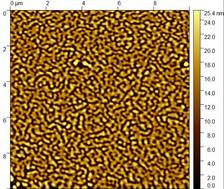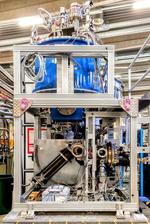Atomic force microscope (AFM) image of a magnetic thin film of organic radicals. (Image: University of Tübingen, Benedetta Casu)
Magnets from organic materials can enable new applications and offer a sustainable alternative to metal magnets containing rare earths. With a worldwide unique experimental setup at PETRA III, scientists from Tübingen, Hamburg, Berlin, Nebraska und Italy have demonstrated magnetism in completely organic thin films for the first time. “These results open the way to the advent of flexible, light and transparent magnets and, thus, to a variety of new futuristic applications,” explains Maria Benedetta Casu from the University of Tübingen who led the research. The team reports its comprehensive analysis in the journal Chem.
Magnetism is a property of matter that has been known to mankind for several thousand years, long before these properties could be described in a theory. “In our everyday lives, we are used to classical magnets made of metals or rare earth alloys, hard materials like the magnets that decorate our fridge,” says Casu. “Let's imagine a class of materials that have a magnetic moment in the complete absence of metal ions, being composed only of light elements, such as carbon, nitrogen, and oxygen. These would be transparent, light, and flexible materials. They would have lower costs of production and could be sustainably produced. This class of materials does indeed exist: it is the family of organic radicals.”
These radicals are organic molecules that carry an unpaired electron, resulting in a permanent magnetic moment that is not due to the effect of an external magnetic field. “Organic radicals are very promising materials for electronics and quantum technology,” says Tobias Junghöfer from the University of Tübingen, one of the main authors of the study. However, to use these radicals in a device, they usually need to be fabricated as a thin film, 1000 times thinner than a human hair, coating a substrate such as silicon dioxide (SiO2). “In the past, magnetism in purely organic radicals was known only for crystals and it was completely unknown in thin films. It was never studied before because this was a huge challenge,” explains Casu.
A decade ago, such experiments were not yet technically possible. “Then, our colleagues at the University of Hamburg developed a high magnetic field machine for ultracold measurements down to 0.1 Kelvin, very close to absolute zero, and much colder than the temperature of outer space,” reports Casu. “However, it was necessary to work with synchrotron light from an advanced source such as PETRA III. The combination of the beamline P04 at PETRA III and our machine is unique and it is the only facility in the world where it is possible to obtain these results.”
The first such experiment was performed in 2016. “The measurements were very time consuming, since it takes several days to cool the sample below 1 Kelvin, and 100 to 150 scans on different points on the sample had to be done for just a single averaged spectrum,” explains co-author Michael Martins from the University of Hamburg. The team used a technique called X-ray magnetic circular dichroism (XMCD) that is a well-established method to investigate classical magnets and to identify their magnetic behaviour. But it was never before used on purely organic materials. XMCD is an element-specific measurement technique that was pioneered at DESY's X-ray source DORIS in the 1980s and can identify all the elements forming a material, based on the absorption of circularly polarized X-rays that leads to so-called electronic transitions in the sample.
“We applied a strong magnetic field at very low temperature to align the single magnetic moments in each molecule of our radical films along the direction of the field,” explains Ivan Baev from the University of Hamburg, also one of the main authors of the study. “The absorption spectra were measured once with left circularly polarized light and once with right circularly polarized light.” Analysing the measurements was not easy. “It took a long time to interpret the data, as this is the first experiment of its kind, but it was very rewarding,” reports Casu. “We have shown that completely organic, light and transparent radical thin films have long-range magnetism, and their magnetic behaviour can be changed depending on the film production, for example by changing the temperature of the coated substrates during coating. This renders organic radicals promising candidates for novel and sustainable magnetic materials.”
Scientists from the Universities of Tübingen, Hamburg and Nebraska, from the Italian Istituto Nanoscienze in Modena and from Helmholtz-Zentrum Berlin contributed to this research.
(from DESY News)
Reference:
Magnetic behaviour in metal-free radical thin films; Tobias Junghoefer, Arrigo Calzolari, Ivan Baev, Mathias Glaser, Francesca Ciccullo, Erika Giangrisostomi, Ruslan Ovsyannikov, Fridtjof Kielgast, Matz Nissen, Julius Schwarz, Nolan M. Gallagher, Andrzej Rajca, Michael Martins, Maria Benedetta Casu; Chem, 2021; DOI: 10.1016/j.chempr.2021.11.021








